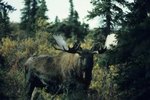
Oxen and bison are both large creatures with imposing presence. However, they're certainly different beasts. Oxen are basically castrated domestic cattle used as working animals. Musk oxen, on the other hand, are similar to bison, sporting shaggy coats. They historically were vulnerable to hunters for their meat and coats.
Ox: The Beast of Burden
Though oxen haven't been faced with depleting numbers as bison and musk oxen have, they don't necessarily have the easy life. From the Bos primigenius line of domestic cattle, oxen are working animals, used for pulling, plowing and hauling. Like steers, the other male bovine, oxen are castrated. However, oxen are allowed to grow to their full size and trained, enabling them to do the work of draft horses. Training includes verbal commands and whip snaps to direct the oxen to move or stop. One of the considerations in choosing whether to develop cattle into oxen is each specimen's horns, necessary for keeping the yoke in place.
Musk Ox
Ovibos moschatus, more commonly known as musk oxen or musk sheep, aren't sheep or oxen but are included in the same Bovidae family. These guys live in the frozen Arctic and Alaska, as well as in other northern areas such as Siberia and Greenland. They manage fine in those frozen climates because they have long, shaggy hair. Their undercoats come and go according to season, providing extra warmth during the winter and falling out when the weather warms up. The guard hairs of the outer coat give extra warmth. Musk oxen are herding animals, staying in groups of two or three dozen, which helps keep predators such as wolves at bay.
Bison
Bison aren't buffaloes, though they're frequently called so in the United States, Buffaloes native to Asia are "water buffalo"; those native to Africa are the African buffalo. The wisent bison (Bison bonasus) is endangered and limited in number in Poland, Lithuania, Belarus, Ukraine and Russia. The plains bison, scientifically known as Bison bison, and the wood bison, formally referred to as Bison bison athabascae, are the largest land animals in North America. The wood bison can be found in Canada; the plains bison was once plentiful throughout much of the continent. Like musk oxen, bison have warm, shaggy coats that are so well-insulated that snow will rest on it instead of melting from body heat. Before the arrival of European settlers, approximately 50 million plains bison roamed the continent; by the early 1900s, the numbers had decreased to fewer than a couple thousand. These guys stay in herds, particularly during mating season.
Big Bovidae
All three of these horned animals are large, but the bison is the biggest of all. Oxen can weigh between 500 and 3,000 pounds, depending on the breed of cattle; many western breeds come in around 2,000 pounds. Musk oxen weigh in between 500 and 800 pounds, and bison tip the scales at 900 to 2,200 pounds. All of these brawny guys are herbivores, with the wild ones grazing on grasses and vegetation.
References
- National Geographic: American Bison
- Animal Fact Guide: American Bison
- San Diego Zoo: American Bison: Bison Bison
- Animal Planet: Ox
- Tillers International: Oxen & Draft Horses Frequently Asked Questions
- National Geographic: Musk-Ox
- Animal Planet: Musk Ox
- The Prarie Ox Drovers: Oxen Questions
- Alaska Department of Fish and Game: Wood Bison
- Ultimate Ungulate: Bison Bonasus
Photo Credits
-
Hemera Technologies/AbleStock.com/Getty Images



